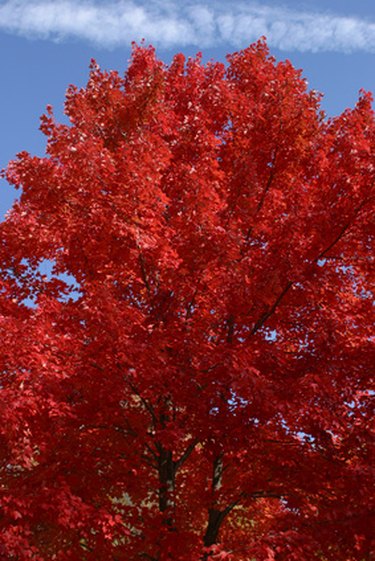
Oak borer insects are a pest of many species of oak trees across North America. They spend a portion of their life cycle inside oak trees where they excavate holes through the wood, causing permanent damage that decreases the value of the timber. Other insect pests, such as carpenter ants, timber worms and carpenter worms, enter through the holes made by oak borers and cause additional damage to the tree. Oak borer infestations that are left untreated often cause tree mortality, according to the University of California. Several insecticide treatments are available for use on oak trees to minimize borer damage.
Biology
Video of the Day
Female oak borers lay upward of 100 eggs on mature oak trees. The eggs are attached in cracks, under lichen or behind vines, where they are protected from predators until they hatch. Larvae then burrow into the outer layers of the wood bark, where they spend their first winter. In their second year, oak borer larvae tunnel their way into the heart wood of the tree to make a pupal cell. The adult hatches from the pupal cell and bores a hole between one-half to 3 inches in diameter through the wood to the surface. Insecticides are designed to disrupt the pattern of reproduction in oak borer insects.
Video of the Day
Chlorpyrifos
Chlorpyrifos is an organophosphate insecticide that is used as a preventative treatment on oak trees where borers are known to be a problem. Chlorpyrifos is a residual insecticide that kills only borers that come in contact with the chemical. The insecticide does not kill larvae that are already inside the tree, but it is highly effective at killing adults that are emerging from infested trees as well as on adults that attempt to lay eggs on trees treated with chlorpyrifos.
Lindane
Lindane is the active ingredient of several insecticide sprays that target oak borers. Lindane acts as a nuerotoxin on oak borers that come in contact with the chemical. The insecticide is most effective when applied during periods of high oak borer activity and functions best as a preventative treatment on healthy oak trees, according to Texas A&M University.
Natural Alternatives
Once an oak tree is infested by borers, there is little that can be done to remove the insects from the tree. However, removing trees that are infested with oak borers from your property will help to prevent the insects from spreading to other trees. According to the U.S. Forest Service, cultural control by removing trees infested with oak borers can reduce the pest population by 95 percent. In addition, facilitating natural predators of oak borers, such as woodpeckers and formacid ants, can help control oak borers.
- U.S. Forest Service: Forest Insect & Disease: Red Oak Borer
- University of California, Riverside: Center for Invasive Species Research: The Goldspotted Oak Borer
- Texas A&M University: Wood-boring Insects of Trees and Shrubs
- Environmental Protection Agency: Pesticides: Reregistration: Chlorpyrifos Facts
- University of Tennessee: Common Tree Borers in Tennessee